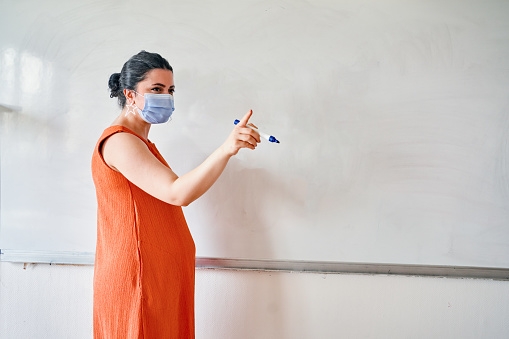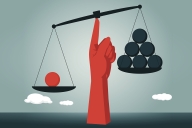You have /5 articles left.
Sign up for a free account or log in.

phynart studio/E+ via Getty Images
During the next few weeks, faculty members in the Unites States, including me, will walk into our face-to-face classrooms with masks on. It is also likely that faculty with accommodations to teach online this fall, or those who work at colleges and universities that temporarily shifted to fully online instruction, will need to teach face-to-face with masks next year as COVID-19 declines but treatments are still in progress.
This will probably be the first time for faculty in this country to teach while masking, no matter if we are new faculty members or have taught college students for decades. Faculty developers who teach faculty how to teach have never done this before, nor is scholarship or research available on the topic. This uncharted teaching territory on top of the fear of contracting the virus is daunting.
But we can seek out strategies and experts to help us teach effectively face-to-face with a mask. I am a tenured associate professor of communication arts and the director of the Center for Excellence in Learning and Teaching at my university. Colleagues in my field of communication and those in allied disciplines like theater and dance know how to mobilize nonverbal strategies and images. Furthermore, interdisciplinary studies of women and gender, public health, and inclusive pedagogy -- all of which are central to my work as a scholar, teacher and faculty developer -- have already advanced useful theories and solutions to related issues.
I’ve listed below some of the main challenges to teaching with a mask, as well as specific strategies for overcoming them. They are part of a training that I designed and am facilitating at my institution called Teaching F2F With a Mask and Creating Caring Classrooms. I personally put these strategies into practice as I prepared for my first day of teaching face-to-face with a mask. The key challenges I foresee are:
Masks dehumanize and medicalize the classroom. In part because they conceal how an individual is reacting personally, masks can lead us to perceive someone as less than human or as an object -- hence the biased belief that someone with a blank facial expression is strange. What’s more, dehumanization and medicalization often go hand in hand. Medicine has a history of objectifying people as specimens, and some health-care practices make it worse, such as how protective gear covers up a doctor’s sadness. Add this context to the current circumstances, in which huge numbers of laypeople are now wearing masks like those worn by medical professionals, and a college classroom could resemble a hospital.
To avoid that, while masking, you can humanize the class by displaying a picture on the projector of yourself without a mask on. Ask your students to show pictures of themselves not wearing masks, too, so you and their peers can fully see them as human beings. That approach aligns with a best practice in online teaching for instructors to make welcome videos that humanize the teacher the students will never meet in person.
Also, the classroom might seem sterile if you wear a white or blue surgical-looking mask. Instead, don one with an aesthetic design or logo on it that symbolizes your personality.
Masks hide our various emotions. With masks on, faculty members and students lose the ability to interpret and use specific facial expressions to emote. Research in communication and psychology reveals how the face is a primary means for communicating feelings and emotions. As a result, a classroom with a teacher and students wearing masks might feel like one does when interacting with someone with a blank facial expression -- they appear emotionless, strange and confusing, and can even project a subtle message to stay away.
To bring emotions back into the classroom, conduct a “temperature check” with emojis at the start of each face-to-face class like K-12 teachers often do. You and your and students can each choose an emoji to display on the projector that reflects how you feel in that moment. You can then adjust your teaching that day to the emotions in the room.
Since eyes, eyelashes and eyebrows are still visible above a face mask, work to “smize” (smile with your eyes). That’s the advice supermodel Tyra Banks, who coined the term “smize,” gave when directing other models to express with their eyes.
Masks stifle speech and sound. Masks filter speech and sound along with the virus. Lecturing and discussion are fundamental pedagogies in higher education, so masks can fundamentally restrict teaching and learning. The inability to hear becomes even more of a problem in larger classrooms. And mask wearing is an accessibility concern: students who are deaf or hard of hearing can no longer read lips when masks conceal people’s mouths.
For centuries, rhetorical scholars have studied public speaking, including the vocal aspects of delivery. Theater faculty are masters of this skill, as well. For example, an acting professor at my university advises faculty members to focus on pacing, pitch, articulation and volume with breath support in order to clearly communicate and connect with students when speaking with a mask.
Dancers remind us that we can also use nonverbal body and hand gestures when teaching with a mask. A dance professor at my university even draws on American Sign Language, which preschool teachers often do. As she says, the teaching body has to be a lot bigger to communicate when masking.
In addition, offices of disability and access services at universities should purchase clear masks for faculty members to teach deaf or hard of hearing students who request that accommodation. Check to see if your institution has done so, and if not request that it does.
Masks divide us. As the news media reports, mask wearing has become politicized in the United States. That claim assumes masks can be neutral, which is not the case: they hide our faces and emotions, can dehumanize and medicalize the classroom, and stifle speech and sound. Besides, face masks are designed to prevent viral transmission between humans -- they form a barrier between ourselves and other people. The division they create between us runs counter to the relational bonding between college students and professors that research shows positively correlates to student success and learning.
To build relationships in the classroom and commit to each other’s well-being by masking, consider co-creating with students a Caring Class Constitution during the first week of the semester. Invite students to envision a caring class. Ask them to share what caring students were like in previous college courses, both inside and outside the face-to-face classroom. Ask if they ever had caring instructors before and what those instructors specifically did.
Finally, ask students to describe the responsibilities of a caring class in the context of COVID-19. Creating a Caring Class Constitution sets public health and academic expectations in a collaborative way, strives to meet the needs of the community as students see themselves in relationship to it, and gives students responsibility for learning and caring for each other alongside the instructor. For instance, in a caring class, if a student didn’t wear a mask, the instructor wouldn’t immediately dismiss the class or reprimand the student. Instead, a Caring Class Constitution might specify that another student would offer an extra clean mask for their peer to wear. An ethic of care calls us to make decisions by enriching relationships and empathizing rather than dividing.
I hope these strategies help us teach face-to-face with a mask on and create caring classrooms during the pandemic. Attention to the teaching body and a humanistic concern for emotion and well-being were always best practices for educators. Their importance should be undeniable now in the COVID-19 era.








